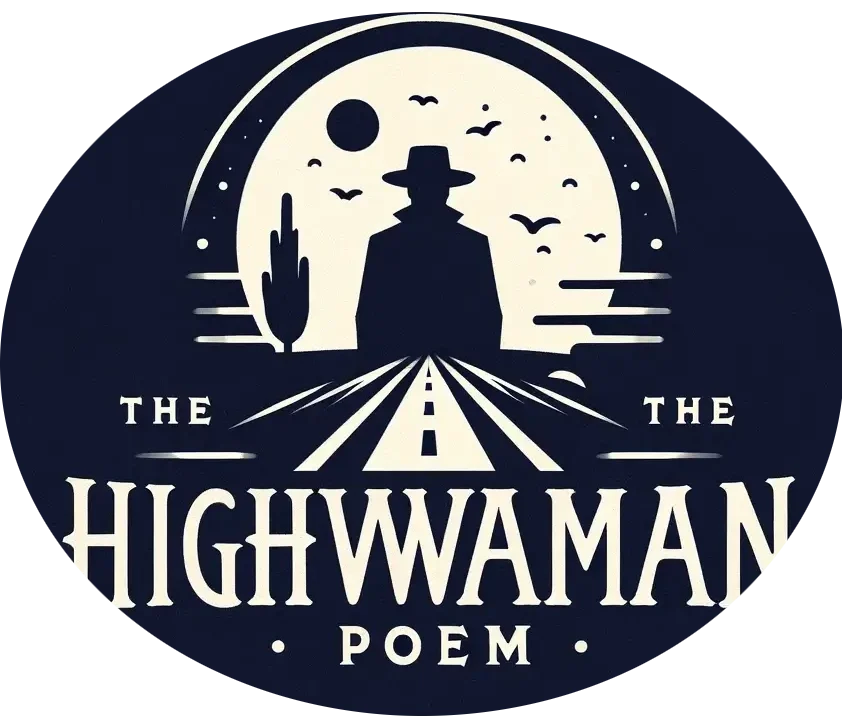The following article offers an in-depth examination of the enduring classic, “The Highwayman” by Alfred Noyes. It presents a thorough overview of essential information, themes, and poetic techniques embodied in this revered poem.
The analysis delves into the poem’s structure, decoding the symbolism and imagery intricately woven throughout the narrative. Whether one possesses a seasoned appreciation for poetry or is a neophyte to the genre, this study guide promises to provide meaningful insights and interpretations.
Embark on a journey into the realm of “The Highwayman” as we unveil its concealed literary riches.
The Highwayman Poem Summary and Key Takeaways:
- Alfred Noyes’ “The Highwayman” tells a tragic love story set in the past with themes of love, betrayal, and loyalty.
- The poem is structured with a strong use of rhyme and repetition, making it easy to memorize and recite.
- Through its use of vivid imagery and symbolism, “The Highwayman” paints a vivid and emotional picture of the characters and their fate.
Overview of The Highwayman Poem
“The Highwayman,” a narrative poem penned by Alfred Noyes, unfolds within the backdrop of 18th-century England. Through its rich narrative, the poem conveys a romantic yet tragic tale, establishing itself as a renowned and esteemed work within the realm of Victorian poetry.
By Alfred Noyes
Alfred Noyes, an esteemed figure in Victorian poetry and the Romantic movement, is widely recognized for his ability to evoke profound emotions and promote individualism through his literary works. His poetic career commenced during the late 19th and early 20th centuries, during which Noyes established himself as a prolific writer, drawing inspiration from nature, folklore, and his personal life experiences.
Notably, his renowned pieces, such as ‘The Highwayman’ and ‘The Barrel-Organ,’ struck a chord with readers by intertwining elements of love, tragedy, and adventure. Noyes’s writing style encapsulated the essence of Romanticism, accentuating the significance of imagination and the articulation of intense emotions.
His impact on Victorian poetry is evident in his distinctive narrative approach, which delves into themes of bravery, integrity, and the human condition.
Key Poem Information
The poem “The Highwayman” is organized in multiple stanzas that employ a combination of hexameter, anapaests, and iambic rhythms to construct its narrative within the backdrop of 18th-century England.
Comprising nine stanzas with varying lengths spanning from four to twelve lines each, the poem adheres to a rhyme scheme of AABB and interchanges between tetrameter and trimeter. This structured rhyme scheme engenders a musical cadence that heightens the dramatic tension embedded within the narrative. The utilization of anapaests and iambic rhythms imbues a sense of urgency and fluidity to the story, emulating the hastening pace of the galloping horse and the imminent peril. These metrical configurations synergistically work together to evoke an aura of suspense, fervor, and tragedy that permeates the entirety of the poem.
Understanding The Highwayman
To grasp the essence of The Highwayman, one must engage in an exploration of its romantic and tragic components situated within the context of 18th-century England, a work masterfully composed by Alfred Noyes.
Meaning and Themes
The poem “The Highwayman” delves into complex themes centered around love, death, and sacrifice, weaving them together with aspects of tragedy and profound emotions commonly found in romantic literature.
Love is intricately portrayed in the poem through the intense and tragic relationship between the Highwayman and Bess, who demonstrate a willingness to risk everything for one another. Their love is symbolically represented by the red love knot in Bess’s hair, serving as a poignant connection that endures even beyond death. The concept of sacrifice is prominently featured in the narrative, particularly in the Highwayman’s ultimate act of selflessness to rescue Bess from the clutches of the soldiers, showcasing his readiness to lay down his life for her well-being. These themes of love and sacrifice serve to amplify the overarching sense of tragedy within the storyline, thereby crafting a moving and emotionally immersive experience for the readers.
Summary of The Highwayman
The poem depicts the tale of the Highwayman and Bess, the landlord’s daughter, and their tragic encounter with the Redcoats at the inn.
Situated against the backdrop of a secluded inn nestled amidst the untamed, moonlit moors, the narrative unravels with an air of mystery and imminent catastrophe.
The Highwayman, a bold and charismatic figure shrouded in black, gallops on his steed towards the inn where Bess eagerly anticipates his arrival. Their love, forbidden and intense, is driven by passion and peril.
Their joyous reunion is disrupted by the arrival of the Redcoats, who set a treacherous snare for the Highwayman. Despite Bess’s courageous effort to forewarn him, tragedy unfolds as the fateful night takes a heart-wrenching turn.
Structure and Poetic Techniques in The Highwayman
When examining the structure and poetic techniques employed in The Highwayman, it becomes apparent that the poem utilizes intricate rhyme schemes, hexameter, anapaests, and iambic meters characteristic of Victorian poetry.
Analysis of Poetic Structure
The poem is structured with stanzas that adhere to a meticulously planned rhyme scheme, incorporating hexameter, anapaests, and iambic meters, often accentuated by enjambment.
This organization of the stanzas not only showcases the poet’s adept utilization of diverse metrical patterns but also contributes to the establishment of a melodious and rhythmic quality throughout the poem.
The strategic positioning of various meters within the stanzas introduces layers of intricacy and profundity to the composition, engrossing the reader in a dynamic exploration of both sound and significance.
By seamlessly connecting certain lines to others through enjambment, the poet constructs a sense of cohesion and fluidity, encouraging the reader to smoothly navigate through the verses and perceive each alteration in meter as a purposeful decision that shapes the overall reading experience.
Key Poetic Techniques
The poem “The Highwayman” utilizes various poetic devices, including repetition, symbolism, foreshadowing, and alliteration, to enrich its narrative and evoke emotional resonance.
Repetition is a prominent literary technique employed throughout the poem, particularly evident in the recurring refrain, “The Highwayman came riding, riding, riding.” This repetitive structure not only establishes a rhythmic cadence but also underscores the significance of the central character.
Symbolism plays a crucial role in the work, with the color red serving as a symbol of love and passion, exemplified through Bess’s scarlet ribbons. Furthermore, alliteration, such as “darkness and dawn” and “glossy green,” contributes to the vivid sensory imagery portrayed in the poem, effectively immersing the reader in the depicted setting.
These literary devices harmoniously intertwine to deepen the exploration of themes centered around love, loyalty, and tragic sacrifice within the narrative.
Interpreting The Highwayman
Analyzing “The Highwayman” necessitates a thorough exploration of its intricate metaphors and evocative imagery, including the spectral galleon and the moonlit setting, which contribute depth to the portrayal of the Highwayman and Bess.
In-depth Analysis of the Poem
A thorough examination of The Highwayman delves into the climactic sequences and the sacrifices undertaken by the Highwayman and Bess, which are underscored through various poetic techniques.
The poem reaches its pinnacle when the redcoats lay siege to the inn in order to apprehend the Highwayman, ultimately resulting in a poignant sacrifice.
The tension escalates as Bess, displaying an act of courage and affection, takes her own life to forewarn her beloved of the imminent peril. This sacrificial moment is intensified by the imagery evoked by the sound of the gunshot reverberating through the night, symbolizing the ultimate dedication and tragedy of their love saga.
The poet’s adept use of personification, such as attributing human qualities to the wind as an entity aiding in the forewarning, heightens the emotional resonance of this crucial juncture.
Exploring Symbolism and Imagery
The poem “The Highwayman” is replete with symbolism and imagery, notably featuring the ghostly galleon, the moon, and the ribbon, which serve to enrich the narrative’s emotional depth and thematic significance.
The spectral presence of the ghostly galleon symbolizes the perpetual haunting of the highwayman’s criminal past, a looming specter that persistently lingers in the narrative, evoking a sense of unresolved history.
Likewise, the moon, with its ever-changing phases, acts as a reflective symbol mirroring the intricate emotions and fates of the characters, illuminating moments of ardor with its radiant glow and veiling instances of sorrow with obscured visibility.
Furthermore, the ribbon functions as a tangible emblem of the enduring connection between the lovers, transcending the constraints of temporal and spatial boundaries, underscoring the resilience of their bond despite adversities.
FAQs about The Highwayman
Common inquiries regarding The Highwayman by Alfred Noyes often pertain to its characters, such as Bess and the Redcoats, as well as the crucial scenes featuring the horse and pistols, which serve as quintessential elements of Victorian poetry.
Readers frequently seek information regarding the romantic yet tragic relationship between the Highwayman and Bess, characterized by themes of love intertwined with peril and treachery. Noyes’s vivid imagery and profound emotional exploration transport readers to a historical period where virtues of loyalty and sacrifice held great significance.
The relentless pursuit by the Redcoats and the climactic resolution of the narrative resonate deeply, underscoring Noyes’s talent in seamlessly blending suspense, passion, and tragedy. The poem’s rhythmic flow and expressive language encapsulate the quintessence of Victorian poetry, renowned for its focus on sentiment, natural beauty, and narrative complexity.
Study Guide for The Highwayman
The study guide for The Highwayman presents a thorough examination of the poem’s stanzas, metaphors, imagery, alliteration, and foreshadowing.
The Highwayman, authored by Alfred Noyes, is a narrative poem that portrays a tragic love story between the highwayman and Bess, against a backdrop of peril and treachery. In the initial stanza, the author employs vivid imagery to illustrate the highwayman’s arrival on his horse at the inn, thereby evoking a sense of enigma and tension. The recurring reference to the term ‘red-coat‘ serves as a symbol of the authoritative presence of the soldiers, alluding to an impending conflict. Noyes utilizes alliteration to enrich the poem’s rhythmic cadence, immersing readers further into the evolving narrative.
Frequently Asked Questions
What is the main storyline of The Highwayman poem?
The Highwayman tells the tragic love story of a highwayman and his beloved Bess, as they face betrayal, sacrifice, and death.
Who is the author of The Highwayman poem?
The Highwayman was written by Alfred Noyes, a British poet and author known for his romantic and narrative style.
What are the key themes in The Highwayman poem?
Some of the major themes in The Highwayman include love, betrayal, loyalty, sacrifice, and tragedy.
What is the symbolism of Bess in The Highwayman poem?
Bess, the main female character, symbolizes love, loyalty, and bravery in the face of danger and tragedy.
How does The Highwayman poem incorporate elements of history?
The Highwayman is set in the 18th century and includes historical details such as the use of flintlock pistols and the description of the British countryside.
What is the significance of the repetition in The Highwayman poem?
The repetitive structure and refrain of “riding, riding” serve to create a sense of rhythm and intensity, enhancing the dramatic and tragic elements of the poem.

